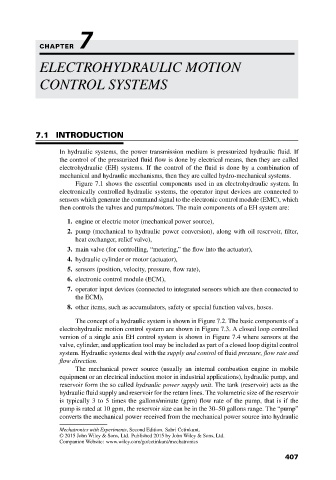Page 421 - Mechatronics with Experiments
P. 421
JWST499-Cetinkunt
JWST499-c07
CHAPTER 7 Printer: Yet to Come October 9, 2014 8:41 254mm×178mm
ELECTROHYDRAULIC MOTION
CONTROL SYSTEMS
7.1 INTRODUCTION
In hydraulic systems, the power transmission medium is pressurized hydraulic fluid. If
the control of the pressurized fluid flow is done by electrical means, then they are called
electrohydraulic (EH) systems. If the control of the fluid is done by a combination of
mechanical and hydraulic mechanisms, then they are called hydro-mechanical systems.
Figure 7.1 shows the essential components used in an electrohydraulic system. In
electronically controlled hydraulic systems, the operator input devices are connected to
sensors which generate the command signal to the electronic control module (EMC), which
then controls the valves and pumps/motors. The main components of a EH system are:
1. engine or electric motor (mechanical power source),
2. pump (mechanical to hydraulic power conversion), along with oil reservoir, filter,
heat exchanger, relief valve),
3. main valve (for controlling, “metering,” the flow into the actuator),
4. hydraulic cylinder or motor (actuator),
5. sensors (position, velocity, pressure, flow rate),
6. electronic control module (ECM),
7. operator input devices (connected to integrated sensors which are then connected to
the ECM),
8. other items, such as accumulators, safety or special function valves, hoses.
The concept of a hydraulic system is shown in Figure 7.2. The basic components of a
electrohydraulic motion control system are shown in Figure 7.3. A closed loop controlled
version of a single axis EH control system is shown in Figure 7.4 where sensors at the
valve, cylinder, and application tool may be included as part of a closed loop digital control
system. Hydraulic systems deal with the supply and control of fluid pressure, flow rate and
flow direction.
The mechanical power source (usually an internal combustion engine in mobile
equipment or an electrical induction motor in industrial applications), hydraulic pump, and
reservoir form the so called hydraulic power supply unit. The tank (reservoir) acts as the
hydraulic fluid supply and reservoir for the return lines. The volumetric size of the reservoir
is typically 3 to 5 times the gallons/minute (gpm) flow rate of the pump, that is if the
pump is rated at 10 gpm, the reservoir size can be in the 30–50 gallons range. The “pump”
converts the mechanical power received from the mechanical power source into hydraulic
Mechatronics with Experiments, Second Edition. Sabri Cetinkunt.
© 2015 John Wiley & Sons, Ltd. Published 2015 by John Wiley & Sons, Ltd.
Companion Website: www.wiley.com/go/cetinkunt/mechatronics
407

